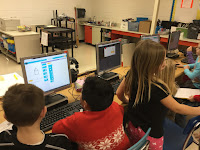Back in October, I wrote about how excited I was to learn about the
Lego Story Starter Kits. These kits looked amazing, and after having some time to work with them, I realized they really are amazing. We were given the funds to purchase a classroom set of Lego Story Starter boxes from our generous and supportive PTO. The first project we have done with the Legos is having our 4th grade students write their own mystery stories. They planned out their stories using
a worksheet, wrote a rough draft on lined paper, and then typed their final draft on a Chromebook using Google Docs. Before even getting to use Legos, these students learned the elements of a mystery story, how to plan out a project, and how to use their imagination to write a story. Once the students finished typing their stories we began using the Legos to build the illustrations for their story. The students built a beginning, a middle, and an ending scene from the Legos. The final step was to put the pictures I had taken of their scenes into the Google Doc.
After doing this project, there are a few things I think went really well, and some things that could be improved upon. First, let me start by saying that I will be doing this project with the 4th grade students again next year, however there will be improvements made. When I look back and think about what we could improve on, it mostly comes down to organization. By having the students complete their planning and rough drafts on paper, this made it possible for worksheets to be misplaced or taken home and forgotten about. Next year, I will have the students complete the worksheet in Google Docs and type their rough draft. After they complete their rough draft, I will show them how to use spell check and have them have at least one classmate critique their story before saving it as the final draft. Another organization issue was in using the Legos. With the way my schedule is, I only had 25 minutes with each 4th grade class every 4 days. This is really not enough to complete even one scene, so the first classes I had using the Legos saved their creations to complete later. This meant that there were not enough Legos for the other classes to complete their creations, and we forgot which bins the Lego pieces came from. To solve this issue I combined my 4th grade classes. Where I usually had one class working on Legos and another checking out books, I simply combined them and let them pause to check out books at a time that worked for them. Next year I will begin the project with a combined class as it seems to make the project go much faster. Finally, in using the Legos I did not leave enough time to clean up so the boxes did not get sorted back to the way they were at the beginning of the unit. Luckily I have some 5th grade girls that will help me out, but next year I will need to spend part of a period explaining how the Legos should be sorted and be more vigilant as the students pick up.
Now on to the great things that have come from this project! First and foremost, the students were having fun learning. The students learned a lot of things, but the thing they will always remember is being able to "play" with Legos in the library. This Lego project allowed me to combine language arts, technology, and art into one lesson. It built community through collaboration as groups of students worked together at Lego bins. It built confidence as students found something they could be successful in, and ultimately, it made the students feel good.


(More pictures to come.)

 Some students quickly got bored with coding. These students were very happy when they returned from Winter Break to learn that we were moving on to other lessons. There were a number of students, however, that were very bummed out that we would no longer be coding. While we were doing the Hour of Code throughout December, I got feedback from the parents of these kiddos that their children were enamored with learning these new coding skills. As I watched the students working together to get through the puzzles on Code.org, I saw students that regularly struggled to just sit still in class becoming successful collaborators on a project. I saw students that struggled to find any success in school build a glow of confidence in their new-found talents. For this reason, I decided that coding needed to be continued in some way with these children.
Some students quickly got bored with coding. These students were very happy when they returned from Winter Break to learn that we were moving on to other lessons. There were a number of students, however, that were very bummed out that we would no longer be coding. While we were doing the Hour of Code throughout December, I got feedback from the parents of these kiddos that their children were enamored with learning these new coding skills. As I watched the students working together to get through the puzzles on Code.org, I saw students that regularly struggled to just sit still in class becoming successful collaborators on a project. I saw students that struggled to find any success in school build a glow of confidence in their new-found talents. For this reason, I decided that coding needed to be continued in some way with these children.








